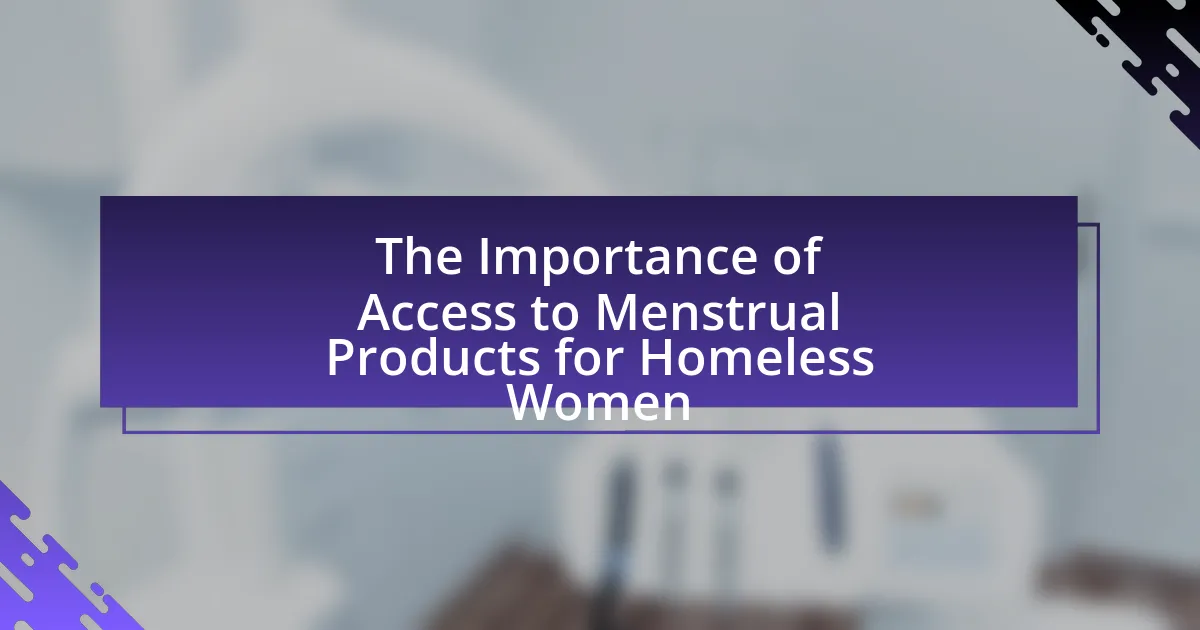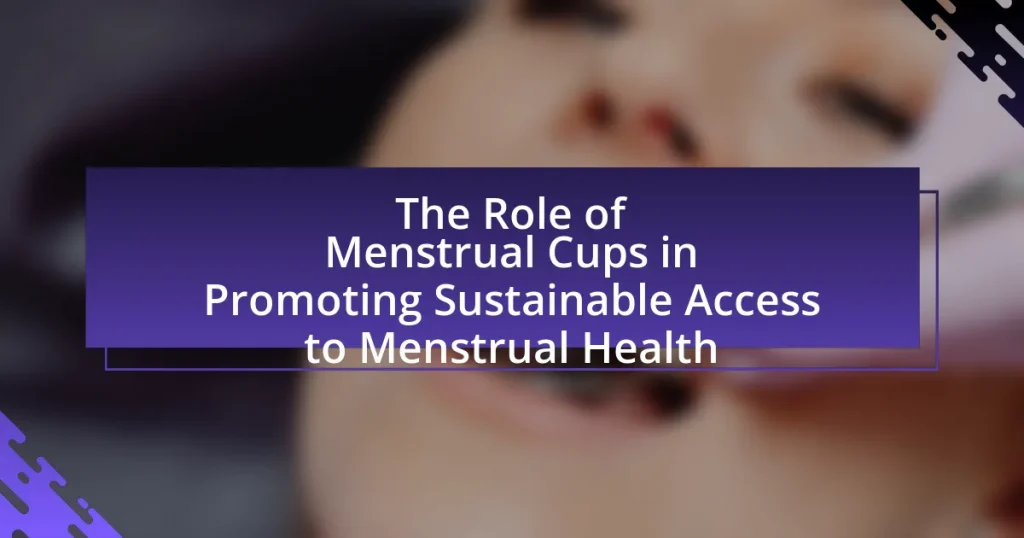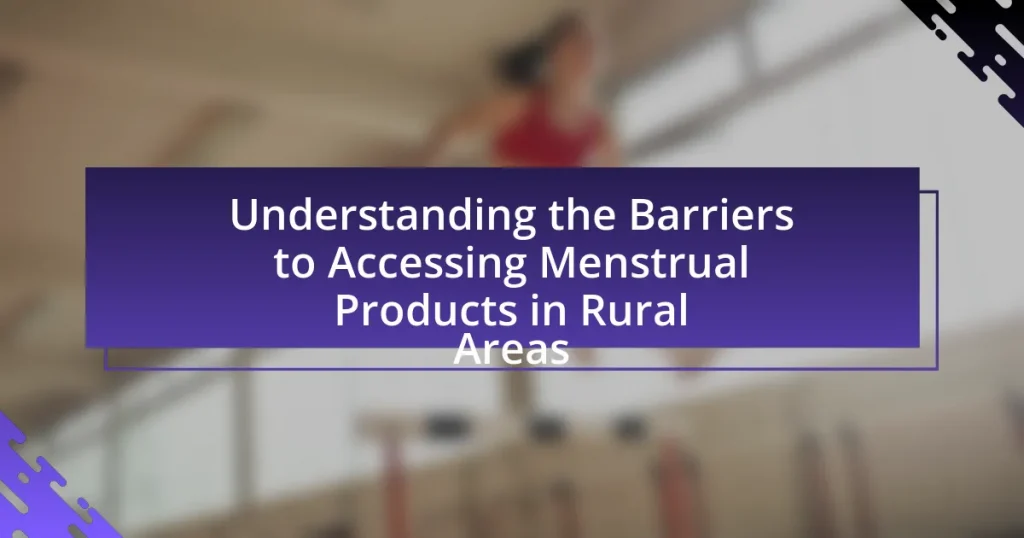Access to menstrual products is essential for homeless women, significantly impacting their health, dignity, and social inclusion. The article explores the challenges these women face, including health risks from inadequate hygiene, psychological effects of stigma, and barriers such as poverty and lack of resources. It highlights the importance of menstrual health in promoting overall well-being and participation in society, while also discussing effective solutions and policies that can improve access to menstrual products. By addressing these issues, the article emphasizes the need for systemic change to support the menstrual health of homeless women.
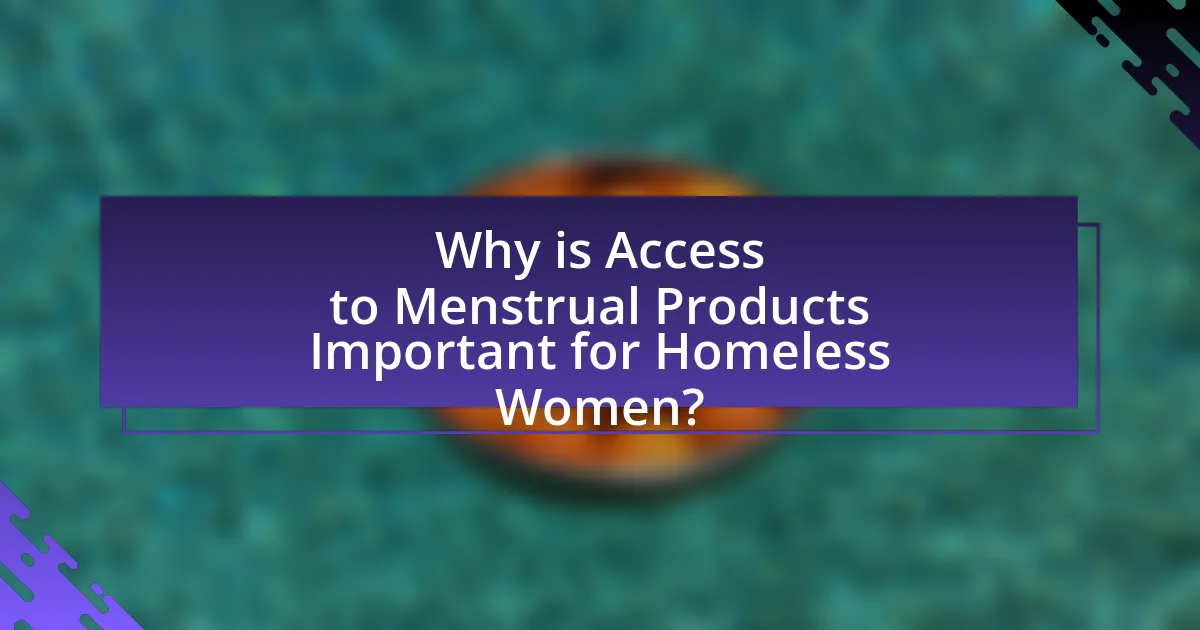
Why is Access to Menstrual Products Important for Homeless Women?
Access to menstrual products is crucial for homeless women because it directly impacts their health, dignity, and ability to participate in daily activities. Without these essential products, women face health risks such as infections and increased stress, which can exacerbate existing health issues. Studies indicate that lack of access to menstrual hygiene products can lead to social stigma and isolation, further hindering their ability to seek employment or engage in community activities. For instance, a survey by the National Network of Homeless Women found that 86% of respondents reported that menstruation affected their ability to maintain employment. Thus, ensuring access to menstrual products is vital for the overall well-being and empowerment of homeless women.
What challenges do homeless women face regarding menstrual health?
Homeless women face significant challenges regarding menstrual health, primarily due to lack of access to menstrual products, inadequate hygiene facilities, and stigma surrounding menstruation. The absence of basic necessities like pads and tampons forces many to resort to unsafe alternatives, which can lead to health complications such as infections. A study by the American Medical Association highlights that 64% of homeless women reported difficulty in obtaining menstrual products, exacerbating their vulnerability during menstruation. Additionally, limited access to clean water and private spaces for changing menstrual products further complicates their situation, leading to increased stress and health risks.
How does lack of access to menstrual products affect physical health?
Lack of access to menstrual products negatively impacts physical health by increasing the risk of infections and exacerbating existing health issues. Women without these products often resort to using unsanitary materials, which can lead to conditions such as bacterial vaginosis and urinary tract infections. A study published in the Journal of Women’s Health found that inadequate menstrual hygiene management is linked to higher rates of reproductive tract infections among women. Furthermore, the stress and anxiety associated with managing menstruation without proper products can lead to mental health issues, compounding the physical health risks.
What psychological impacts arise from inadequate menstrual hygiene?
Inadequate menstrual hygiene can lead to significant psychological impacts, including anxiety, depression, and low self-esteem. Women experiencing poor menstrual hygiene often face stigma and shame, which can exacerbate feelings of isolation and distress. Research indicates that inadequate access to menstrual products can result in increased stress and anxiety levels, as women may worry about managing their periods in public or while homeless. A study published in the Journal of Women’s Health found that women without access to menstrual products reported higher rates of mental health issues, highlighting the critical link between menstrual hygiene and psychological well-being.
How does access to menstrual products influence overall well-being?
Access to menstrual products significantly influences overall well-being by promoting health, dignity, and social inclusion. When individuals have reliable access to menstrual products, they can manage their menstruation effectively, which reduces the risk of health issues such as infections and discomfort. Research indicates that lack of access can lead to negative mental health outcomes, including anxiety and depression, as individuals may feel embarrassed or ashamed about their situation. Furthermore, studies show that access to menstrual products allows individuals to participate fully in daily activities, such as work or school, thereby enhancing their social and economic opportunities. For instance, a report by the American Medical Association highlights that 1 in 5 women have missed work or school due to lack of access to menstrual products, underscoring the critical link between product availability and overall well-being.
In what ways can menstrual product access improve quality of life?
Access to menstrual products significantly improves the quality of life for individuals by promoting health, dignity, and social inclusion. When individuals have reliable access to menstrual products, they can manage their menstruation effectively, reducing the risk of health issues such as infections and discomfort. Studies indicate that lack of access can lead to negative health outcomes, including increased absenteeism from work or school, which can hinder educational and economic opportunities. Furthermore, having menstrual products available fosters a sense of dignity and self-worth, allowing individuals to participate fully in daily activities without the fear of stigma or embarrassment. Research from the American Medical Association highlights that menstrual product access is essential for mental well-being, as it alleviates anxiety related to menstruation management. Thus, ensuring access to menstrual products is crucial for enhancing overall quality of life.
How does menstrual health relate to social inclusion for homeless women?
Menstrual health is crucial for social inclusion among homeless women as it directly impacts their dignity, health, and ability to participate in society. Access to menstrual products allows these women to manage their periods effectively, which is essential for maintaining hygiene and preventing health issues. Studies indicate that lack of access to menstrual products can lead to increased stigma and social isolation, as women may avoid public spaces or social interactions during menstruation due to embarrassment or fear of inadequate management. For instance, a report by the Homeless Period Project highlights that many homeless women report feeling ashamed and excluded from society when they cannot access necessary menstrual supplies. This exclusion can perpetuate cycles of poverty and marginalization, making it imperative to address menstrual health as a key component of social inclusion efforts for homeless women.
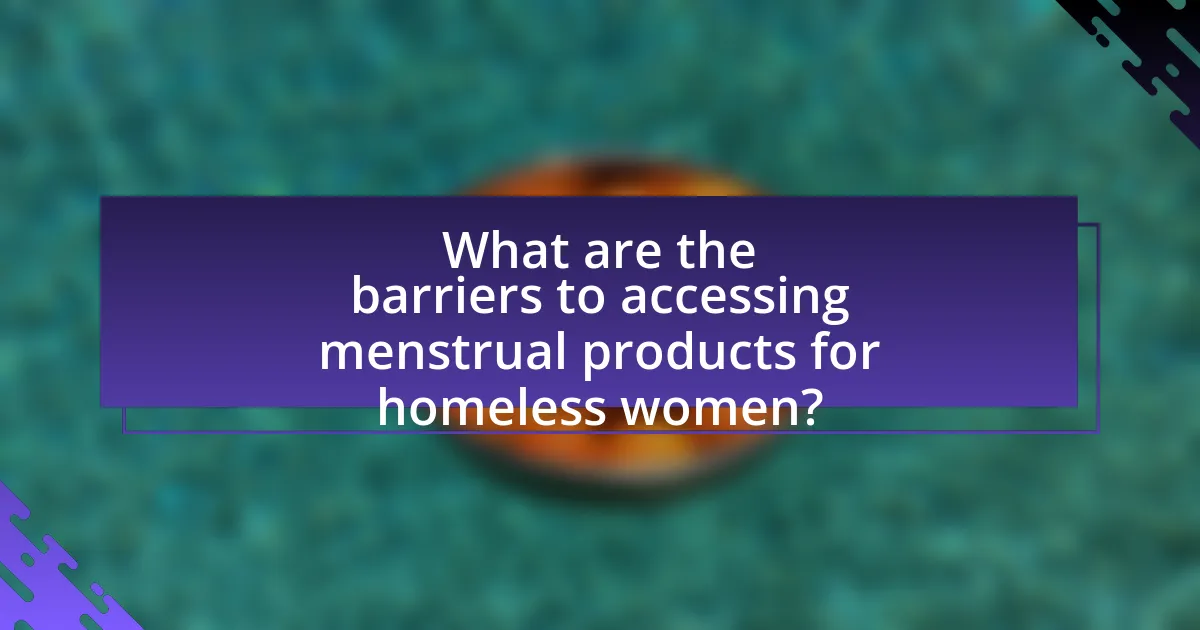
What are the barriers to accessing menstrual products for homeless women?
Homeless women face significant barriers to accessing menstrual products, primarily due to lack of financial resources, limited availability of products in shelters, and social stigma. Financial constraints prevent many homeless women from purchasing menstrual products, as they often prioritize basic needs like food and shelter. Additionally, many shelters do not stock menstrual products, making it difficult for women to obtain them when needed. Social stigma surrounding menstruation can also discourage women from seeking help or discussing their needs, further exacerbating the issue. According to a study published in the Journal of Women’s Health, 86% of homeless women reported difficulty accessing menstrual products, highlighting the urgency of addressing these barriers.
How do economic factors limit access to menstrual products?
Economic factors limit access to menstrual products primarily through affordability and availability issues. Many individuals, particularly those experiencing homelessness, face financial constraints that make purchasing menstrual products a low priority compared to basic needs like food and shelter. According to a study by the American Medical Association, 1 in 5 women in the U.S. has struggled to afford menstrual products, highlighting the significant impact of economic hardship on access. Additionally, limited availability in shelters and public spaces exacerbates the issue, as many facilities do not provide these essential items, further restricting access for those in need.
What role does poverty play in menstrual product accessibility?
Poverty significantly restricts access to menstrual products, as financial constraints prevent individuals from purchasing necessary hygiene items. According to a study by the American Medical Association, nearly one in five women in the U.S. has struggled to afford menstrual products, leading to the use of unsafe alternatives. This lack of access can result in health risks, increased absenteeism from work or school, and a negative impact on overall well-being. Furthermore, organizations like Period and the Alliance for Period Supplies report that low-income women often prioritize basic needs such as food and shelter over menstrual hygiene, exacerbating the challenges faced by those in poverty.
How do financial constraints affect the choices of menstrual products?
Financial constraints significantly limit the choices of menstrual products available to individuals, particularly among homeless women. When faced with limited financial resources, many women opt for lower-cost options such as disposable pads or homemade alternatives, which may not provide adequate protection or comfort. Research indicates that 64% of low-income women have reported using less effective menstrual products due to financial limitations, leading to health risks such as infections and increased discomfort. Additionally, the lack of access to a variety of products can result in missed work or school days, further exacerbating the challenges faced by homeless women.
What systemic issues contribute to the lack of access?
Systemic issues contributing to the lack of access to menstrual products for homeless women include poverty, inadequate healthcare policies, and social stigma. Poverty limits financial resources, making it difficult for homeless women to afford essential hygiene products. Inadequate healthcare policies often fail to address the specific needs of homeless populations, resulting in insufficient distribution of menstrual products in shelters and public spaces. Additionally, social stigma surrounding menstruation can lead to a lack of awareness and support, further exacerbating the issue. For instance, a study by the American Medical Association found that 1 in 5 women in the U.S. have struggled to afford menstrual products, highlighting the intersection of economic and social barriers.
How do social stigma and discrimination impact access to menstrual products?
Social stigma and discrimination significantly hinder access to menstrual products for homeless women. These societal attitudes often lead to feelings of shame and embarrassment, causing individuals to avoid seeking help or resources. For instance, a study published in the journal “BMC Women’s Health” found that 64% of women experiencing homelessness reported feeling embarrassed when trying to obtain menstrual products, which directly affects their willingness to access necessary supplies. Additionally, discrimination can result in limited availability of menstrual products in shelters and public spaces, as organizations may prioritize other needs over menstrual hygiene. This lack of access exacerbates health issues and perpetuates the cycle of poverty and marginalization for homeless women.
What policies exist that hinder or help access to menstrual products?
Policies that help access to menstrual products include initiatives that provide free menstrual products in schools, shelters, and public restrooms, which aim to reduce period poverty. For example, some states in the U.S. have enacted laws mandating that public schools provide free menstrual products, recognizing the necessity for equitable access. Conversely, policies that hinder access include taxation on menstrual products, often classified as luxury items, which can increase financial barriers for low-income individuals. In many regions, the lack of funding for social programs that distribute menstrual products further exacerbates the issue, leaving vulnerable populations without essential supplies.

What solutions can improve access to menstrual products for homeless women?
To improve access to menstrual products for homeless women, implementing distribution programs through shelters and community organizations is essential. These programs can provide free menstrual products directly to those in need, ensuring that homeless women have reliable access. For instance, studies indicate that initiatives like the “Period Project” have successfully distributed thousands of menstrual products to shelters, highlighting the effectiveness of targeted outreach. Additionally, partnerships with local businesses can facilitate product donations, further enhancing availability. Research shows that when menstrual products are readily accessible, it significantly reduces the stigma and health risks associated with menstruation among homeless women.
How can community organizations support menstrual health initiatives?
Community organizations can support menstrual health initiatives by providing access to menstrual products, education, and advocacy. These organizations can distribute free menstrual supplies to homeless women, addressing the critical need for hygiene products that many lack. For instance, studies show that 1 in 5 women in the U.S. have struggled to afford menstrual products, highlighting the urgency of this issue. Additionally, community organizations can conduct workshops to educate women about menstrual health, thereby reducing stigma and promoting awareness. By advocating for policy changes that ensure menstrual products are included in public assistance programs, these organizations can further enhance access and support for menstrual health initiatives.
What types of programs have proven effective in providing menstrual products?
Programs that have proven effective in providing menstrual products include school-based initiatives, community distribution programs, and partnerships with local organizations. School-based initiatives often distribute menstrual products directly to students, addressing the needs of young women in educational settings. Community distribution programs, such as those run by food banks and shelters, ensure that menstrual products are accessible to homeless women and low-income individuals. Partnerships with local organizations, including non-profits and health services, enhance the reach and effectiveness of these programs by leveraging existing networks to distribute products efficiently. For example, a study by the University of California found that programs providing free menstrual products in schools significantly reduced absenteeism among menstruating students, highlighting the impact of accessible menstrual hygiene management.
How can awareness campaigns change perceptions about menstrual health?
Awareness campaigns can significantly change perceptions about menstrual health by educating the public, reducing stigma, and promoting understanding of menstrual hygiene management. These campaigns often utilize various media platforms to disseminate factual information, which helps to challenge misconceptions and stereotypes surrounding menstruation. For instance, a study published in the Journal of Public Health found that targeted educational interventions increased knowledge about menstrual health and improved attitudes towards menstruation among participants. By fostering open discussions and providing accurate information, awareness campaigns empower individuals to view menstrual health as a normal and essential aspect of overall health, thereby enhancing societal acceptance and support for those affected.
What role do government policies play in enhancing access to menstrual products?
Government policies play a crucial role in enhancing access to menstrual products by establishing frameworks that ensure affordability, availability, and education. For instance, policies that eliminate taxes on menstrual products, such as the “tampon tax,” directly reduce costs for consumers, making these essential items more accessible. Additionally, government initiatives that fund the distribution of menstrual products in shelters and public facilities address the needs of homeless women, ensuring they have access to necessary hygiene products. Research indicates that when governments implement comprehensive menstrual health policies, such as those seen in countries like Scotland, which became the first to make menstrual products free, it significantly improves access and reduces stigma associated with menstruation.
What legislative measures can be taken to ensure menstrual product availability?
Legislative measures to ensure menstrual product availability include mandating the provision of free menstrual products in public spaces such as schools, shelters, and community centers. For instance, states like New York and California have enacted laws requiring public schools to provide free menstrual products, recognizing the necessity for access among students. Additionally, legislation can incentivize manufacturers to produce affordable menstrual products through tax breaks or subsidies, thereby increasing availability in low-income areas. Research indicates that lack of access to menstrual products can lead to significant health and social issues, underscoring the importance of these legislative actions.
How can public health initiatives address menstrual hygiene for homeless women?
Public health initiatives can address menstrual hygiene for homeless women by providing access to menstrual products, education on menstrual health, and safe disposal options. Initiatives such as distributing free menstrual supplies through shelters and community organizations have been shown to significantly improve hygiene and health outcomes for homeless women. For instance, a study published in the Journal of Women’s Health found that access to menstrual products reduces the risk of infections and enhances the overall well-being of women experiencing homelessness. Additionally, educational programs can empower women with knowledge about menstrual health, while establishing safe disposal methods can help maintain public hygiene and dignity.
What practical steps can individuals take to support homeless women in need of menstrual products?
Individuals can support homeless women in need of menstrual products by organizing donation drives to collect menstrual hygiene items such as pads, tampons, and menstrual cups. These drives can be conducted in community centers, schools, or workplaces, encouraging people to contribute essential products. Additionally, individuals can partner with local shelters and organizations that serve homeless populations to ensure that the collected items are distributed effectively. Research indicates that access to menstrual products significantly impacts the health and dignity of homeless women, as highlighted in a study by the American Medical Association, which found that lack of access can lead to health complications and increased stigma. By taking these practical steps, individuals can directly address the urgent needs of homeless women and contribute to their well-being.
